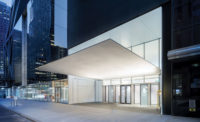Architects Respond to a Call for Post-Sandy Aid

A house destroyed by Hurricane Sandy in the Far Rockaway neighborhood of Queens, New York.
Photo © Ian Reid
Lance Jay Brown, a professor of architecture at the City University of New York (CUNY), says he was overwhelmed by architects’ response to last week’s superstorm. A group he co-founded, Design for Risk and Reconstruction (a standing committee of the New York chapter of the American Institute of Architects), put out a call for help “and within 24 hours, there were more than 200 responses” from architects willing to survey affected neighborhoods. Their job would be to help the city evaluate uninhabited buildings, a kind of architectural triage: green stickers are placed on buildings that can be inhabited immediately, yellow on buildings that can be inhabited after remediation, and red on buildings that cannot be made safe. Brown refers to it as “second-responder work.”
 |
|
Another home damaged by Hurricane Sandy in the Far Rockaway neighborhood of Queens, New York. Photo via Flickr user buzzthrill
|
Now Brown and Illya Azaroff, also a CUNY professor (and, also like Brown, a practicing architect), with whom he runs the committee, are organizing training for the first 30 architects who answered their call. At sessions provided with the help of the national AIA, the architects will be taught how to safely perform the building assessments, as well as how to enter their findings into a city database so that progress on the yellow-stickered buildings can be tracked.
But that doesn’t mean the architects will get to try out their new skills anytime soon. According to Brown and others, architects are prevented from performing damage assessment—as volunteers—by the absence of a law to protect them from future liability. About half the states have “good samaritan” laws that cover architects, allowing them to do volunteer work in emergencies without fear of lawsuits. But New York is without such protection. “Legislation exists, but it just hasn’t been passed,” says Brown, who has been involved in the fight for a “good sam” law since 2004, as has the state AIA office in Albany. “We lobby for it constantly, but lawyers lobby against it,” Azaroff explains, adding, “As a Brooklyn architect, I should be able to walk across the street and help a neighbor. This is something that would promote a better society.”
Still, in first few days after Hurricane Sandy, members of the AIA chapter on hard-hit Staten Island helped Department of Buildings employees inspect several hundred buildings. Because of the liability problem, the architects were careful to "take a background role" and not sign off on any paperwork, says Anselmo Genovese, president of the chapter.
Meanwhile, Brown and Azaroff want a cadre of trained architects poised to help when legislation is enacted and to assist in other states where “good sam” laws exist. They are also currently assembling groups of architects to perform neighborhood-scale evaluation, which doesn’t raise such liability concerns. The committee is preparing to send out five teams of architects, possibly this weekend, to identify needs for temporary housing and possible locations for that housing, either buildings that can be converted to shelters or sites where temporary housing could be built. People staying with friends or relatives, says Brown, “will wear out their welcome at some point.”
As for the involvement of architects in building-by-building damage assessments, the list of interested architects keeps growing. “There’s more willingness than opportunity,” says Brown. “People are saying, ‘When can I get to work?’ It’s frustrating that we can’t be out there now.”



